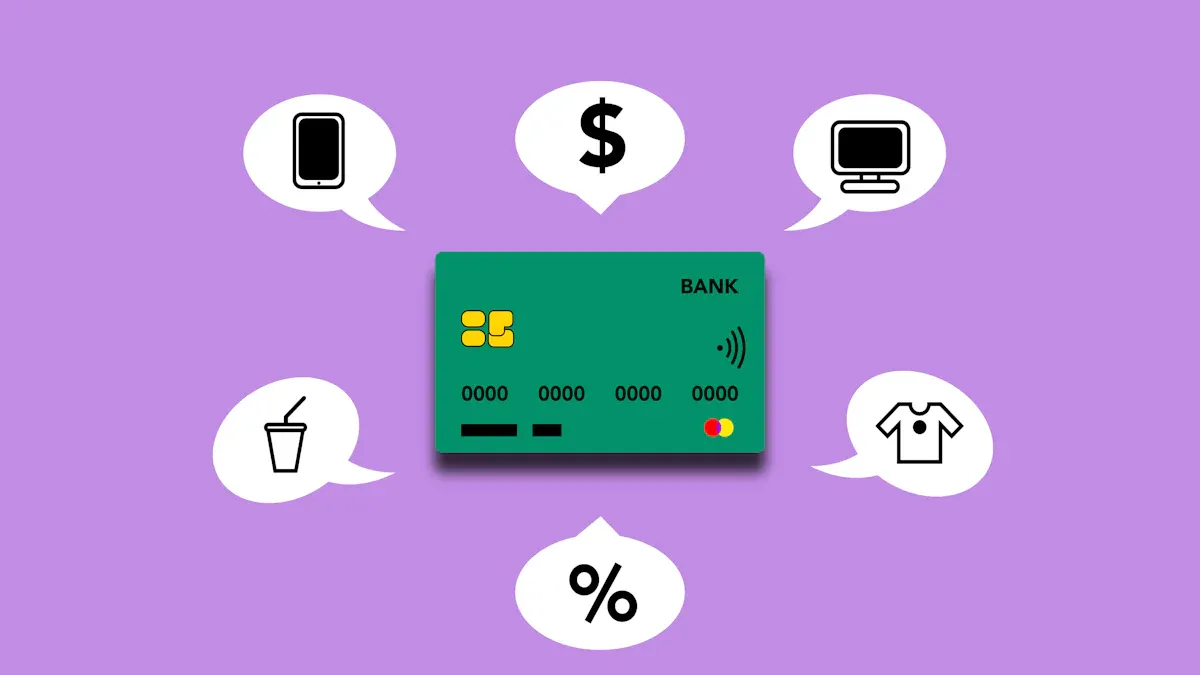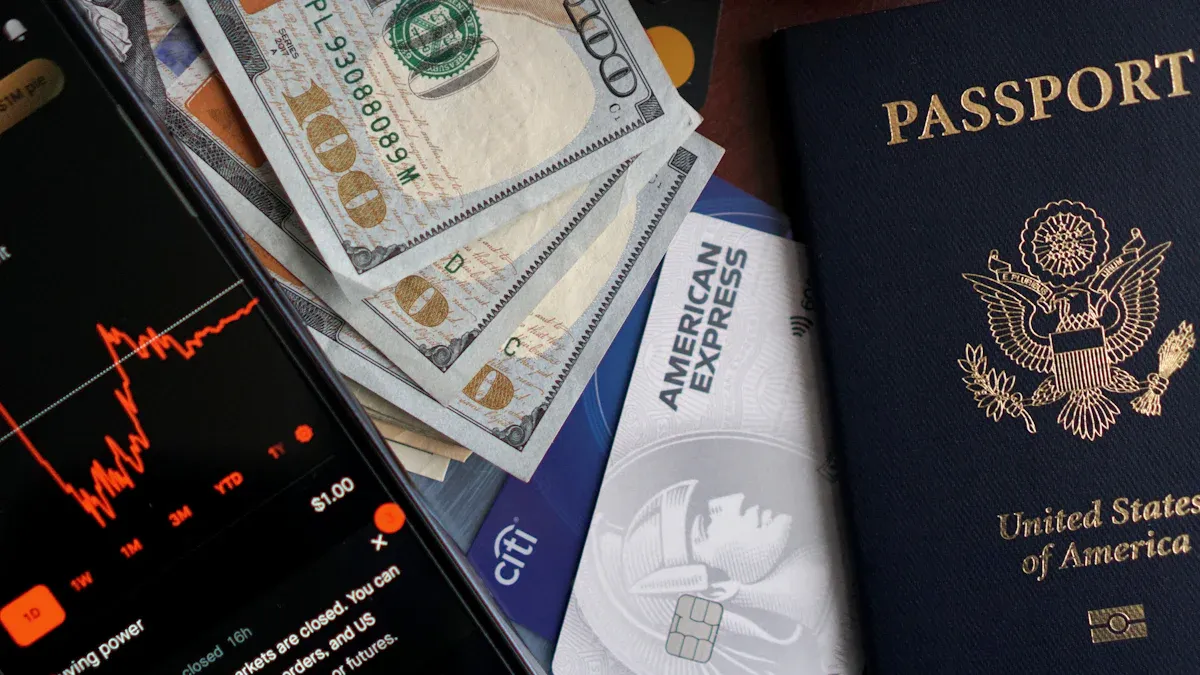- EasyCard
- Trade
- Help
- Announcement
- Academy
- SWIFT Code
- Iban Number
- Referral
- Customer Service
- Blog
- Creator
Common Exchange Rate Traps in International Remittances and Methods to Secure the Best Rates Safely

Image Source: pexels
When making international remittances, you often encounter exchange rate traps that can cost you significant amounts of money. The table below shows the financial losses associated with different remittance methods:
| Remittance Method | Type of Financial Loss | Example Loss Amount | Remarks |
|---|---|---|---|
| Third-Party Payment Platforms | Exchange Rate Spread + Withdrawal Fees | Approximately $300 | Losses incurred by cross-border e-commerce sellers when withdrawing via PayPal |
| International Credit Cards | Dynamic Currency Conversion (DCC) Fee | Approximately 500 RMB | Losses incurred by tourists using credit cards in Europe |
| Localized Remittance Services | Exchange Rate Markup + Fixed Fees | Approximately $100 | Losses incurred by migrant workers using Western Union |
| Bank Wire Transfers | Exchange Rate Spread Markup 1%-3% | Significant losses for large remittances | Exchange rate traps are common, and fees are complex |
Exchange rate fluctuations can also directly affect the amount received. You can:
- Monitor real-time exchange rates and choose services with competitive rates.
- Plan remittance timing wisely to minimize losses due to unfavorable rates.
- Compare different remittance services to reduce costs and increase the amount received.
You need to be cautious of exchange rate traps and learn the right methods to make every remittance worthwhile.
Key Points
- Be wary of hidden fees and exchange rate markups during international remittances, as these traps can lead to overpaying and reduced amounts received.
- Choosing transparent platforms with rates close to the market mid-rate can effectively lower remittance costs and risks.
- Utilizing exchange rate alerts and locking features to plan remittance timing can avoid losses due to rate fluctuations.
- Comparing exchange rates and fees across different services helps select the best option, saving significant remittance costs.
- Avoid falling for false claims like “zero fees” or “super high rates” to prevent fraud and ensure fund safety.
Exchange Rate Traps

Image Source: pexels
When making international remittances, you often encounter various exchange rate traps. These traps not only cost you extra money but also make it difficult to predict the amount received. Below, I’ll guide you through the most common exchange rate traps, with real-world examples to help you stay vigilant.
Hidden Fees
Many banks and remittance platforms emphasize low fees in their promotions but fail to disclose all cost details. You may encounter the following types of hidden fees:
- Currency conversion fees: Banks typically add a markup to the market exchange rate during currency conversion, increasing your costs.
- Other additional fees: Services like check collection, online banking, and cross-border payment verification incur extra charges. Sometimes, penalties are applied for breaching service terms (e.g., overdrafts or late payments).
- Implicit fees: Some fees are not explicitly stated in contracts and only appear after the transaction, making it hard to estimate total costs in advance.
- Low fee transparency: Actual charges are often higher than expected, especially hidden fees, making it difficult to calculate total expenses accurately.
- Regional differences: Fee structures vary significantly across countries and regions, and international remittance fees may fluctuate due to geopolitical factors.
- Business scale sensitivity: Banks adjust fees based on business size and type, with small and medium enterprises often facing higher fee pressures.
Be aware that hidden fees account for a significant portion of international remittance costs. While traditional banks and remittance companies charge fixed fees, their exchange rates are often higher than the market mid-rate, with the difference being a hidden fee. For example, Wise uses the market mid-rate, with transparent fees typically below 1%, and total costs (including fixed fees and conversion fees) are usually under 2%, with no hidden fees. In contrast, traditional banks’ hidden fees can cost you significantly more.
Exchange Rate Markups
Exchange rate markups are one of the most common traps. When remitting, banks or platforms typically don’t offer the market mid-rate but add a markup. For instance, Standard Chartered Bank in Hong Kong’s “bank rate” is approximately 0.5%-1.2% higher than Google’s real-time mid-rate. This markup may seem small, but for a $5,000 remittance, the combined markup and fees could cost you an extra $36.7 to $67.48. Bank transfers often have higher fees and may include third-party SWIFT fees.
Exchange rate markups directly reduce the amount received by the recipient. Even with the same remittance amount, the final amount received varies significantly due to different markup levels. Choosing transparent, low-markup platforms like Wise can effectively minimize the impact of markups on the amount received.
Tip: You can optimize exchange rate costs by checking real-time quotes via online banking or apps and transacting on weekdays to reduce losses from exchange rate traps.
Exchange Rate Fluctuations
Exchange rate fluctuations are another common trap. During the remittance process, rates can change at any time, exposing you to the following risks:
- Unpredictable fluctuations may cause you to pay more or receive less, with the risk borne by you.
- The bank’s quoted rate may differ from the rate at the time of your application, requiring you to reconfirm the transaction rate.
- Once a transaction is finalized, it cannot be reversed, so you must verify all details.
- Market disruptions may interrupt transactions, and banks typically bear no responsibility.
- During sharp fluctuations, the bid-ask spread widens, increasing your risk.
Remitting during periods of high volatility can lead to greater losses due to sudden rate drops or spikes. Learn to monitor market trends, time your remittances wisely, and avoid periods of significant fluctuations to reduce the risk of exchange rate traps.
Exaggerated Claims
Some platforms use exaggerated claims to attract you, such as “zero fees” or “super high rates,” but actual transactions hide various fees or even pose fraud risks. Here are some real cases:
- Ms. Wang from Panzhihua, Sichuan, believed private transactions would save money but was asked for additional fees after paying a deposit, ultimately losing her money without receiving goods.
- Ms. Zhang from Fuyang, Anhui, was lured by a fake investment platform on a dating site, transferring over $100,000 and losing it all due to alleged penalties preventing withdrawals.
- Mr. Cao from Xuzhou, Jiangsu, was induced by a WeChat group to engage in task scams, losing over $60,000 after being asked for continuous transfers.
- Ms. Fang from Zhenjiang, Jiangsu, was deceived by someone posing as a relative, repeatedly transferring payments and deposits, only to be scammed.
- Mr. Wu from Hongkou, Shanghai, was defrauded in an online romance scam involving fabricated family tragedies, losing over $200,000.
These cases show that exaggerated claims not only cost you extra but may also lead to fraud traps. Choose legitimate channels and beware of “super high rates” or “zero fees” to avoid falling into exchange rate traps.
Securing the Best Exchange Rates

Image Source: pexels
Platform Comparison
When choosing an international remittance service, the first step is to compare exchange rates and fees across platforms. Fee structures vary widely—some platforms charge based on spreads, while others use percentages or fixed amounts. For example, cash remittances typically have lower fees, while credit or debit card remittances have higher fees. The larger your remittance, the lower the fee percentage generally is. Remittances to Europe or the U.S. often have lower fees than to other regions.
You can use online tools like Wise or Tenpay Global to compare real-time rates and fees. Wise uses the market mid-rate with transparent fees, averaging 3 times cheaper than U.S. banks. Tenpay Global offers rate locking with fees as low as 0.3% and fast transfers. By using these tools and analyzing rate trends, you can typically reduce remittance costs by 10%-30%, saving around $1,800 monthly. This helps avoid losses from exchange rate traps.
Tip: Bookmark frequently used remittance platforms and regularly compare rates and fees to choose the best option.
Exchange Rate Alerts
Exchange rate changes directly impact the amount received. Major platforms offer rate alert and locking features. For example, NetEase Pay allows you to set a target rate, and the system notifies you when it’s reached. You can also book currency exchange and lock rates for the next 7 days to avoid fluctuation risks. Heshi Financial Platform offers similar features, allowing you to set fluctuation ranges for automatic alerts.
These features are ideal for bulk currency exchanges during specific procurement periods or frequent payments to overseas suppliers. Automated rate locking reduces overall costs and uncertainty from fluctuations.
Suggestion: Install a rate alert app on your phone to monitor changes and seize the best remittance timing.
Optimal Timing
Choosing the right time to remit is crucial, as rates fluctuate daily, sometimes significantly. Monitor macroeconomic news, such as Federal Reserve rate hikes or trade policy changes, which impact USD rates. You can also split large remittances into smaller batches to reduce the risk of single-transaction fluctuations.
Banks offer forward contracts for large remittances, locking future rates with fees of about 0.5%-1%, often better than spot rates. By timing remittances wisely and using alerts and locking features, you can maximize cost savings.
Reminder: Exchange currency in advance during low-rate periods or use booking functions to lock favorable rates, avoiding exchange rate traps.
Legitimate Channels
Always prioritize legitimate channels when choosing a remittance platform. These platforms offer transparent rates and fees while ensuring fund safety. Wise, Revolut, and Tenpay Global provide real-time rate comparisons and alerts to help you remit at the optimal time and reduce costs. Beware of non-legitimate platforms promising “super high rates” or “zero fees,” which often hide traps or fraud risks.
Check the platform’s regulatory certifications, user reviews, and terms of service to ensure it’s regulated by financial authorities. Legitimate platforms typically display all fees and rates on their websites, allowing you to calculate total costs in advance.
Note: Avoid “private currency exchange” ads on social media or WeChat groups, as they carry high risks of fraud.
Practical Recommendations
Tool Usage
You can use various mainstream rate comparison tools to quickly check and compare real-time rates across platforms. Common steps include:
- Use online converters (e.g., XE Currency, Google Currency Converter) to check real-time exchange rates and understand currency relationships.
- Download mobile apps (e.g., XE Currency App or Hong Kong bank apps) to access the latest rate information anytime, anywhere.
- Use forex trading platforms (e.g., Forex.com, MetaTrader) for real-time data, suitable for users with investment needs.
- Check rates and process exchanges via Hong Kong banks’ online or phone banking services.
- For professional analysis, use platforms like Reuters Eikon for market insights and historical rate data.
These tools support multi-currency conversions, historical rate queries, and market analysis. Set rate alerts to receive notifications when rates hit your target, helping you avoid traps and seize optimal timing.
Risk Mitigation
Identifying unreliable platforms and preventing fraud is critical during international remittances. Take these steps:
- Be cautious of common remittance scams, such as currency exchange fraud, impersonation of government agencies, investment scams, and high-paying job traps.
- Avoid private exchange channels recommended via social media or strangers to prevent legal risks from traps or money laundering.
- Choose platforms with strict risk controls, like XTransfer, which uses verification to detect abnormal transactions and ensure fund safety.
- Protect personal information, avoid clicking unknown links, or downloading unverified software to prevent data leaks.
- If you encounter suspicious situations, verify through official channels, report to authorities if needed, and contact your bank for stop-payment requests.
Tip: Stay updated on safety alerts from Chinese embassies abroad to enhance risk awareness.
Compliance Requirements
When making cross-border remittances, you must comply with the laws and regulations of the relevant countries. Different countries have strict limits and compliance rules:
- Hong Kong residents have a daily limit of 80,000 RMB for remittances to China (approximately $11,000, subject to real-time rates).
- Large remittances undergo strict bank reviews, and exceeding limits may trigger tax or forex authority investigations.
- You must provide legitimate proof of remittance purpose, and banks verify suspicious transactions to prevent money laundering.
- Non-compliance may lead to warnings, fines, or criminal liability. Banks may reject or freeze funds, impacting your credit record.
Understand the policies of both sending and receiving countries to ensure every remittance is compliant and safe, avoiding traps and legal risks.
When making international remittances, you often face exchange rate traps that increase costs and threaten fund safety. Follow these key steps to remit safely and secure the best rates:
- Regularly monitor rate trends and choose stable periods to avoid fluctuations from major economic events.
- Use rate alert functions to seize favorable timing and minimize unnecessary losses.
- Select platforms with encryption and transparent fees to ensure fund and data safety.
- Register accounts through official channels for compliant and smooth operations.
By continuously monitoring rate information, you can reduce cash flow and exchange loss risks, preventing operational losses from fluctuations. Real cases show that users adopting these methods experience significant improvements in remittance experience and efficiency.
Rationally choose legitimate channels, actively compare rates and fees, monitor rate changes, and apply these practical tips to every remittance. This way, you can effectively avoid exchange rate traps, enhancing fund safety and management efficiency.
FAQ
1. How can I determine if a platform is legitimate for international remittances?
Check if the platform is certified by financial regulatory authorities. Review user feedback and terms of service. Hong Kong banks and well-known third-party platforms are generally safer.
2. How can I reduce exchange rate losses for large remittances?
Split remittances into batches to avoid high-fluctuation periods. Use Hong Kong banks’ forward contracts to lock rates in advance, minimizing losses.
3. How do I set up exchange rate alerts?
Find rate alert functions in mainstream remittance or Hong Kong bank apps. Set your target rate, and the system will notify you to seize the best timing.
4. What should I do if I encounter a remittance scam?
Immediately contact the platform’s customer service and your bank to request a stop-payment. Report to authorities and retain all transaction records as evidence.
5. Are there limits on remittances between China and the U.S.?
Yes. Chinese residents have a daily remittance limit to the U.S., typically $80,000, adjusted based on real-time rates. Consult your bank in advance.
This article provides an in-depth analysis of common exchange rate traps in international remittances, including hidden fees, rate markups, exchange rate volatility, and misleading promotions. The article uses real-world examples to illustrate how these traps lead to financial losses and offers detailed prevention strategies. Furthermore, it provides practical methods for securing the best exchange rates, such as comparing platforms, using rate alerts and lock-in features, timing remittances wisely, and choosing legitimate channels. By following these recommendations, users can effectively mitigate risks and ensure that every remittance is cost-effective and secure.
However, despite the detailed content of the article, a core challenge for many Chinese investors remains: the flow of cross-border funds. Traditional funding methods, such as international bank wire transfers, are not only complex and time-consuming but also come with high fees and opaque exchange rate spreads. These issues can directly impact investment returns and increase transaction costs.
BiyaPay was created to solve these cross-border financial pain points. We offer a smoother, more cost-effective channel for your investments. We support the conversion between various fiat and digital currencies, allowing you to easily manage global assets, and provide a real-time exchange rate query feature to ensure you always get the best rates. What’s more, our remittance fees are as low as 0.5% with same-day delivery, significantly cutting down your transaction costs and time. Now, you don’t need a complex overseas account to invest in both U.S. and Hong Kong stocks on one platform. Say goodbye to the hassle of cross-border payments and start your efficient financial journey. Register with BiyaPay today to make fund management as smooth as trading.
*This article is provided for general information purposes and does not constitute legal, tax or other professional advice from BiyaPay or its subsidiaries and its affiliates, and it is not intended as a substitute for obtaining advice from a financial advisor or any other professional.
We make no representations, warranties or warranties, express or implied, as to the accuracy, completeness or timeliness of the contents of this publication.




Contact Us
Company and Team
BiyaPay Products
Customer Services
is a broker-dealer registered with the U.S. Securities and Exchange Commission (SEC) (No.: 802-127417), member of the Financial Industry Regulatory Authority (FINRA) (CRD: 325027), member of the Securities Investor Protection Corporation (SIPC), and regulated by FINRA and SEC.
registered with the US Financial Crimes Enforcement Network (FinCEN), as a Money Services Business (MSB), registration number: 31000218637349, and regulated by FinCEN.
registered as Financial Service Provider (FSP number: FSP1007221) in New Zealand, and is a member of the Financial Dispute Resolution Scheme, a New Zealand independent dispute resolution service provider.




















